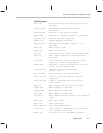
Texas Instruments C614 Synthesis Code
6-13
Applications
These files may be edited for special purpose code
INIT.ASM and SPEAK.ASM
These files should never be edited
SLEEP.ASM, RAM.IRX and SPK_RAM.IRX
A good rule of thumb to follow is that files under the DSP directory should be
left alone, and all custom code should be added either to MAIN.ASM or to a
new directory under MODULES, e.g., MODULES\CUSTCODE.
Creating a New Project
The easiest way to create a new project is to copy the entire MELP1 directory
into another directory. Rename the project file as desired, eg NEWPROJ.RPJ.
It is not necessary to change the paths of the files in the project – this will be
done automatically by the code development tool.
6.3.1 Memory Overlay
C614 release code uses memory overlay to accommodate multiple synthesis
algorithms. If the user is interested in using the data memory, the starting
memory location has to start from the last memory location used by the
program + 2. The synthesis code has a file named MAIN_RAM.IRX. This file
is provided for maintaining overlay. New variables are added as follows:
; bytes
byte1 equ RAMSTART_CUSTOMER + 1
byte2 equ byte1 + 1
; words
word1 equ byte2 + 2 * 1
word2 equ word1 + 2 * 1
; byte arrays
array1 equ word2 + 10
; word arrays
array2 equ array1 + 2 * 4
; End of RAM
RAMEND_CUSTOMER equ array2
RAMLENGTH_CUSTOMER equ RAMEND_CUSTOMER –
RAMSTART_CUSTOMER
Two byte variables, two word variables and two arrays are assigned storage
space in realtion to the previous variable. The last two rows must be present
and the constant RAMEND_CUSTOMER should equate to the name of the
last used variable in the list. Note that the C614 RAM is always accessed as
byte, therefore 1 word memory location is equal to 2 bytes. Hence the
multiplication by 2.


















